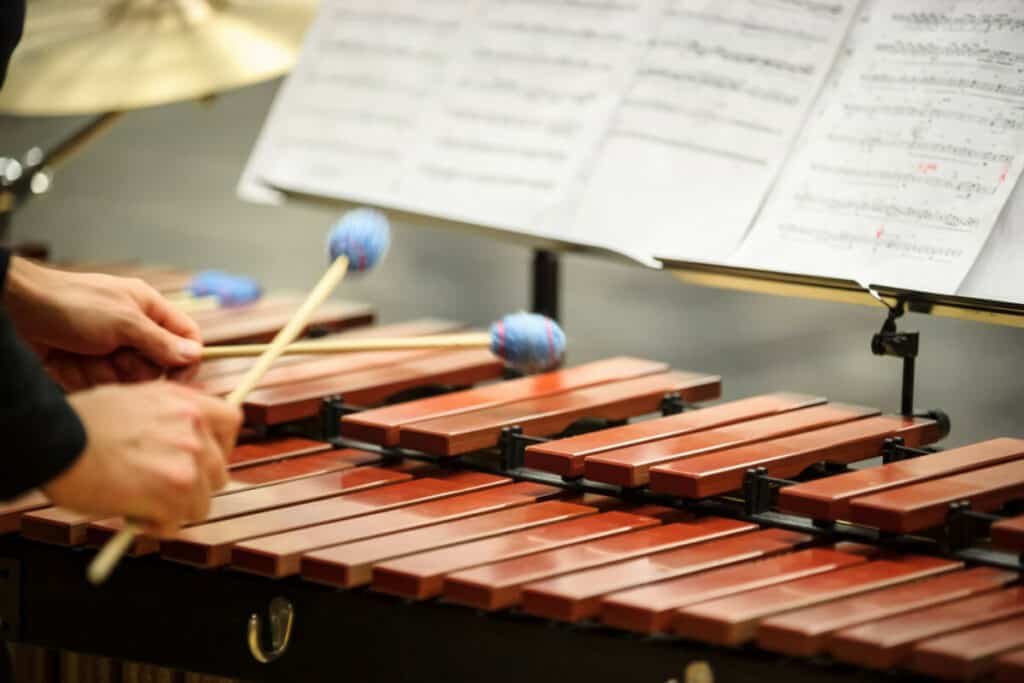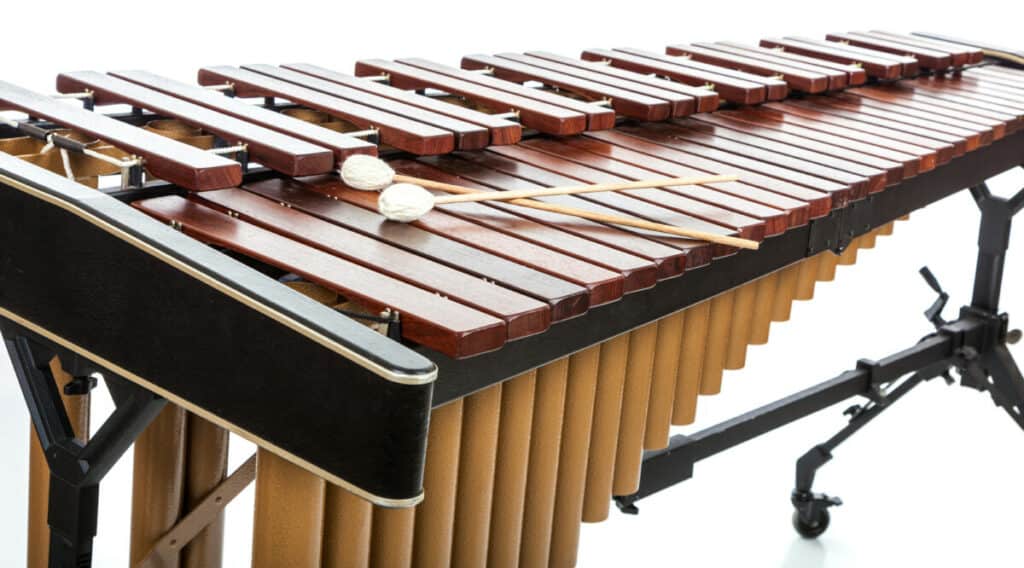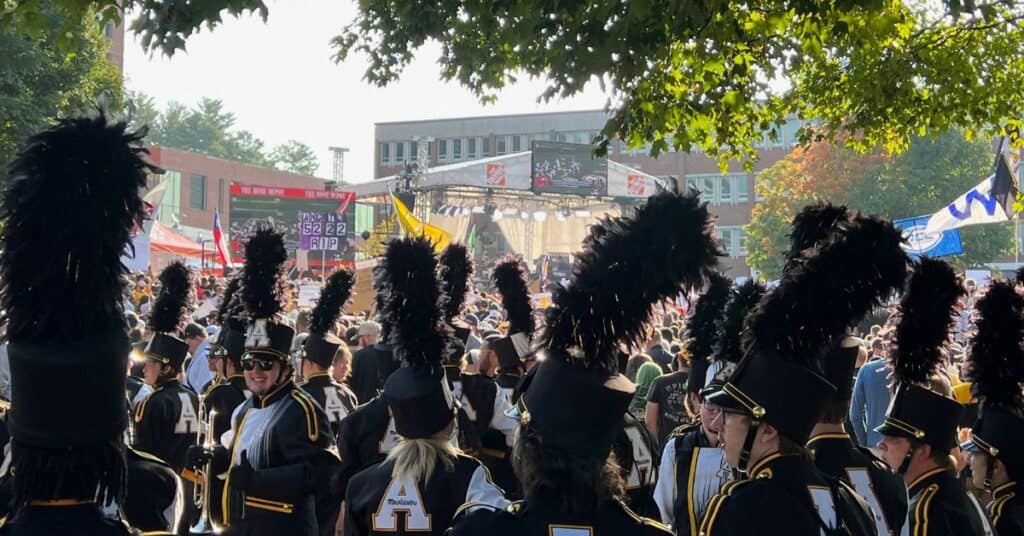Do college marching bands have a pit?
College-level sports are entertaining to watch and attend. There is the main event, usually football, surrounded by cheerleaders, food stands, and merchandise stores. Often there is also a marching band playing melodious tunes on the field and in the stands, however, some may wonder if college marching bands have percussionists playing alongside them.

Many college marching bands do have a pit, or a front ensemble, as part of their marching band. This allows the marching band to play music that otherwise would not sound good without instruments such as the marimba, xylophone, synthesizer, and other small and hard-to-carry instruments.
Now that we understand that college marching bands have a front ensemble, there are a few other things that are good to understand and know about college marching bands. These would include a list of which colleges have a pit in their marching band, why some colleges do not have a pit, how to audition for a slot in a college marching band as a front ensemble member, and what to expect as a percussionist playing at a collegiate level.
Which Colleges Have a Pit in Their Marching Band?
Unlike high school marching bands, where having a front ensemble is a given, college marching bands often lack the resources to have a pit. Yet, some colleges advertise that they have a front ensemble loud and proud. Here is a small list of colleges that have a front ensemble. (Source)
- University of Oklahoma
- University of Massachusetts Amherst
- James Madison University
- Arizona State University
- University of Nebraska- Lincoln
- Texas Tech University
- University of Arkansas
- University of Northern Texas
- University of Texas at San Antonio
- University of Texas at Arlington
- Texas State University
- University of Texas at El Paso
- Texas Christian University
This is not an all-encompassing list, but a sample of the many available options. Some might notice the list has many Texas and southern-based universities. The southern region of the United States has a strong love of marching band that surpasses the high school level.
At the high school level, southern high schools have strong and large marching band programs that often compete in regional or national competitions. This love and drive to play leads to the college level. It is more likely that people will find front ensembles at the college level in the southern region of the United States.
However, the only way to know for sure whether a school has a pit in the marching band is to look into the music department at a specific college and ask. School tours can be incredibly helpful for people interested in being a part of a front ensemble while attending college.
Why do Some College Marching Bands Lack a Front Ensemble?
There are a variety of reasons that college marching bands might choose to not include a front ensemble. Some of the reasons are because of a lack of funding. High schools are funded by taxes and donations from alumni. This is usually much more funding than they receive at the collegiate level. Most of the other instruments in a marching band are owned by the students and don’t have to be purchased.
However, the front ensemble almost always relies on the school providing the instruments they need. Marimbas, Xylophones, Synthesizers, Cymbals, and other instruments are usually much more expensive than traditional marching instruments. This leads to them cutting out the front ensemble entirely.
Another reason college marching bands don’t have front ensembles is that college marching bands have a different purpose than high school-level marching bands. College marching bands usually only play at football games and do not compete.
Half-time at the college level is a lot stricter with time than at high school. Often, the marching band does not have the time or space to set up a front ensemble in time for the halftime show. Some marching bands even learn new shows constantly, which is harder for front ensembles than for individuals. Often, front ensembles add another level of difficulty for marching bands to work around musically.

The largest reason is that many college-level marching bands are student-run and not connected to the music department. This hints that there is no sharing of instruments or resources from the music department. People struggle to afford college at all, let alone additional instruments that they don’t get to keep and are expected to donate to the program. All of these reasons lead to many colleges choosing not to have a front ensemble.
How to Audition to Play in a College Marching Band as a Front Ensemble Member
The first thing to note is that the school will likely expect interested musicians will audition either in person or through video submission. Most college marching bands do not take anyone who is willing to pay the fees like in high school.
Often, the marching band audition will have two or three segments of music that challenge different aspects of musical ability, like speed and rhythm, dynamics, and might even test to see if a musician can do four mallets effectively. My brother spent many hours working on the music in order to submit it by a specific deadline.
Once a person feels they have practiced enough/the deadline approaches, then the individual submits the audition and waits to hear back from the marching band. This is usually through email or calling.
The most important thing to remember is that every school is different. Some are relaxed and might accept anyone with an interest. Looking into the specific school is the best route to see what is required. (Source)

What to Expect as a Percussionist at the Collegiate Level
There are many things that people should expect when playing as a percussionist at the collegiate level. One of the biggest ones is the time commitment. Pit members should expect at least ten hours of practice a week and the entire day of any game day. (Source)
This may seem like an equivalent/smaller commitment than high school. However, the school expects the students to have certain grades in college, and college courses require more hours to maintain higher grades. Another important thing to consider is that the music is likely to be more technically challenging. It is hard work to be in a college marching band!
With all of this in mind, it becomes a lot easier to understand what it means to be a part of a college marching band. It is a highly rewarding experience for many who love the thrill of game day and musical achievement. The front ensemble is ultimately a wonderful addition to any marching band.
